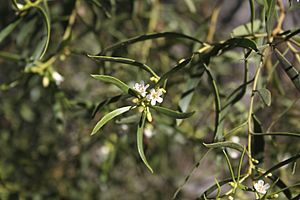Sugarwood facts for kids
Quick facts for kids Sugarwood |
|
|---|---|
 |
|
| Myoporum platycarpum growing near Cocklebiddy in the Nuytsland Nature Reserve | |
| Scientific classification | |
| Genus: |
Myoporum
|
| Species: |
platycarpum
|
| Synonyms | |
|
|
Myoporum platycarpum, known by several common names including sugarwood, false sandalwood and ngural, is a plant in the figwort family, Scrophulariaceae. When it's young, it looks like a rounded bush with bright green leaves. As it gets older, its bark becomes rough, dark grey, and cracked. Sugarwood grows naturally in the southern half of Australia.
Contents
What Does Sugarwood Look Like?
Sugarwood can be a rounded bush or a small tree. It can grow up to 10 m (30 ft) tall. Its leaves and branches are smooth, but they often have small, raised, wart-like bumps called tubercles. Older trees have rough, dark grey bark that can peel off.
The leaves grow one after another along the stem. They are usually 37–72 mm (1–3 in) long and 4–9 mm (0.2–0.4 in) wide. Their shape is long and narrow, sometimes oval. They often have small teeth or jagged edges on the outer half. The leaves can be curved or have a hook at the end. Both sides of the leaves are a deep green color.
Sugarwood Flowers and Fruits
Sugarwood flowers grow in groups of about 5 to 8, sometimes more or fewer. Each group grows on a small stalk about 3.8–7.2 mm (0.1–0.3 in) long. Each flower has five triangle-shaped sepals. It also has five petals that are joined at their bases to form a tube.
The petals are white or a very light pink to purple. They sometimes have orange or yellow spots. The flower tube is about 1.9–4 mm (0.07–0.2 in) long. The petal tips spread out and are blunt, measuring 1.6–4.8 mm (0.06–0.2 in) long. The inside of the tube and part of the petal tips are hairy. There are 4 stamens that stick out beyond the petals.
Sugarwood mainly flowers from August to November. After the flowers, green, fleshy fruits grow. These fruits become dry when they are fully grown.
How Sugarwood Got Its Name
The plant Myoporum platycarpum was first officially described by a botanist named Robert Brown. He wrote about it in his book Prodromus Florae Novae Hollandiae in 1810.
There are two slightly different types of this plant, called subspecies:
- Myoporum platycarpum subsp. platycarpum: This type has petal tips that are shorter than the petal tube. When it's a mature tree, its branches are often curved or bent.
- Myoporum platycarpum subsp. perbellum: This type has petal tips that are as long as or longer than the petal tube. When it's a mature tree, its branches are straight.
The second part of the scientific name, platycarpum, comes from ancient Greek words. Platys means "broad" or "flat," and karpos means "fruit." So, it means "flat-fruited." The name perbellum comes from Latin and means "very beautiful."
Where Does Sugarwood Grow?
Both types of Myoporum platycarpum grow in inland areas of New South Wales, north-western Victoria, and the southern half of South Australia. Only the platycarpum subspecies is found in south-eastern Western Australia and the far south-east of Queensland. It often grows in areas with mallee trees or Belah woodlands.
How People Use Sugarwood
Growing Sugarwood in Gardens
Sugarwood is a tough and attractive plant. It's great for providing shade, shelter, or as a screen in dry climates.
Sugarwood Timber
The wood from Sugarwood is hard and heavy. It's yellow with brown streaks and small black marks. When you work with the wood, it smells like sugar!

